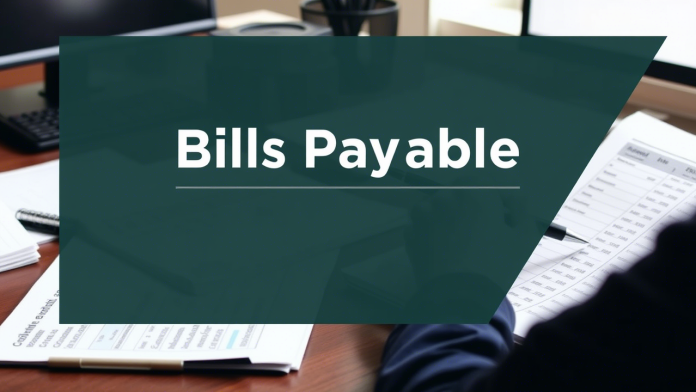In the realm of accounting, understanding the classification of various accounts is essential for maintaining accurate financial records. One such account that frequently appears in business transactions is Bills Payable. If you’re curious about what type of account it is and how it fits into the broader framework of accounting, this blog will provide a comprehensive explanation.
Bills payable are business documents that show the amount owing for goods and services sold on credit. Bills payable can include service invoices, phone bills and utility bills. Small businesses that track their financial accounting using the accrual method have to carefully record their business debts. Properly managing bills payable ensures that a company maintains an accurate picture of its liabilities, which is vital for effective cash flow management and financial planning.
By understanding the nature of bills payable and their role in accounting, businesses can better organize their financial responsibilities and maintain a healthy balance sheet.
Bills Payable in Final Accounts
To fully grasp the concept of bills payable, it’s important to first define what it represents and then explore its role in final accounts.
What is Bills Payable?
Bills Payable refers to written promises made by a business to pay a specific amount of money to its creditors or suppliers at a future date. These are formal agreements, often in the form of promissory notes, acknowledging the debt owed for goods or services purchased on credit.
For example, if a company buys raw materials from a supplier and agrees to pay within 90 days, it may issue a bill payable as evidence of the obligation.
Classification: A Liability Account
Bills Payable is classified as a liability account in accounting. This means it represents an obligation or debt that the business must settle in the future. Liabilities are amounts owed by a business to external parties and bills payable fall under this category.
Types of Liability:
- Current Liability: If the payment is due within one year, bills payable are categorized as a current liability.
- Non-Current Liability: If the payment extends beyond one year, it is considered a non-current liability.
For instance, if a business has issued a bill payable that is due in six months, it will be recorded as a current liability. However, if the payment is due after two years, it will be classified as a non-current liability.
Role of Bills Payable in Final Accounts
Final accounts, also known as financial statements, summarize a company’s financial position at the end of an accounting period. These include the Balance Sheet, Profit & Loss Account, and other supporting schedules. Bills Payable plays a significant role in these statements.
Placement in the Balance Sheet
The Balance Sheet provides a snapshot of a company’s financial health, showing assets, liabilities, and equity. Bills Payable is listed under the liabilities section of the balance sheet. Specifically:
- It appears under current liabilities if the payment is due within a year.
- If the payment is deferred for more than a year, it is recorded under non-current liabilities.
This placement ensures that stakeholders, such as investors and creditors, can assess the company’s short-term obligations and its ability to meet them.
Impact on Working Capital
Working capital is the difference between current assets and current liabilities. Since bills payable are part of current liabilities, they directly affect working capital calculations. A higher amount of bills payable reduces working capital, indicating that the business has more short-term obligations to fulfill.
For example:
- If current assets = $50,000 and current liabilities (including bills payable) = $30,000, then working capital = $20,000.
Monitoring bills payable helps businesses manage their liquidity and ensure they have enough resources to cover immediate debts.
Reconciliation with Creditors
When preparing final accounts, businesses must reconcile their bills payable with creditor accounts. This ensures accuracy and transparency in financial reporting. Any discrepancies between the company’s records and those of its creditors need to be resolved before finalizing the accounts.
Why is Bills Payable Important?
Effectively managing bills payable is crucial for several reasons:
- Cash Flow Management: Timely payments help maintain good relationships with suppliers and avoid penalties or interest charges.
- Creditworthiness: Consistently honoring bills payable enhances the company’s reputation and improves its credit score.
- Financial Planning: Understanding your liabilities allows for better budgeting and forecasting.
Conclusion
Bills Payable is a critical component of a company’s financial structure, representing its short-term or long-term obligations to creditors. As a liability account, it plays a vital role in the preparation of final accounts, particularly the balance sheet. Proper management of bills payable ensures smooth cash flow, strengthens supplier relationships, and contributes to overall financial health.
By understanding the nature of bills payable and their significance in final accounts, businesses can make informed decisions and maintain robust financial practices. Whether you’re an entrepreneur, accountant, or student of finance, mastering this concept is key to navigating the complexities of accounting with confidence.
Read more:-
- Top 8 Advantages of Mobile Apps within Pharmacy Management Software.
- Connected Banking in Marg Pharmacy Software: Streamlining Financial Workflows for Modern Pharmacies.
- How Billing Software with Barcode Billing Improves Operations at FMCG Stores.
- Zero-Stock or over-Stock? How does a Pharmacy Software Brings Balance.
- NDPS Act 1985: Why Every Modern Pharmacy Needs Advanced Pharmacy Billing Software




















